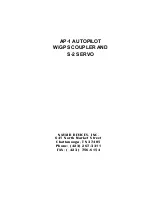
- 11 -
Set the SPAN trimpot in the AP-1 fully clockwise, then rotate the TURN CONTROL
from stop to stop and note the maximum obtainable aileron deflection. Adjust the servo
RANGE trimpot as necessary to obtain about 50 of full aileron deflection at the limits of
TURN CONTROL rotation.
SETTING SERVO OVERRIDE FORCF.
The servo TORQUE CONTROL nut (the locknut inside the servo on the output shaft)
sets the override force, which is the force you feel at the stick when the servo clutch
begins to slip.
Set the TURN CONTROL to neutral and then push the stick hard enough to override the
servo. Set the override force to a value that seems strong enough to give fairly good roll
authority, but not so strong as to be difficult to override. In subsequent flight tests, work
toward setting the servo slip clutch to the minimum torque necessary to give enough roll
control to handle a reasonable amount of turbulence.
If you tighten the clutch enough to exceed the 30 in-lbs maximum torque rating, you may
hear a loud clacking sound in the servo and the servo may disengage. This clacking
happens when the force pushing the gears apart exceed the solenoid's ability to hold the
gear train engaged. This is a redundant safety feature-just back off on the control nut a
little and recycle the power switch to re-engage the servo.
CONNECTIONS TO NAV RECEIVERS
Fig. 3 shows the autopilot interconnection wiring diagram. As stated earlier, the power
and ground conductors should be #18 or larger. The servo signal wire and push-to talk
switch wiring may be as fine as #24, or whatever heavier wire is convenient.
Use the supplied braided shield twin lead for the LORAN signal; do not use foil shield. If
you need extra, call Navaid Devices. Ground the shield on only one end (Fig. 3 shows
grounding at the AP-1 end). This shielded wiring is necessary only if you are connecting
to a LORAN—it prevents the gyro motor from lowering the signal to noise ratio.
When soldering the shield, be careful not to let the shield overheat the plastic and short to
the conductor. If you separate enough braid so that it can be held by a pair of needle nose
pliers while soldering, the heat from the braid will be soaked up by the pliers without
damaging the insulation.
The diode installed in series with the push-to-talk line, together with the wire connected
from the PTT switch to pin 7, are used to kill the signal to the servo while the PTT switch
is depressed. This prevents the servo from jumping around due to the presence of high
level RFI (radio frequency interference) on the power lines. The servo stays engaged
during the voice transmission, but it does not move until normal operation is restored by
releasing the mike button.
Содержание AP-1
Страница 2: ......
Страница 9: ...7 WIRING DIAGRAM FOR HAND HELD GPS AND AP 1 WITH GPS COUPLER WIRING DIAGRAM Fig 3...
Страница 27: ...A 3...














































